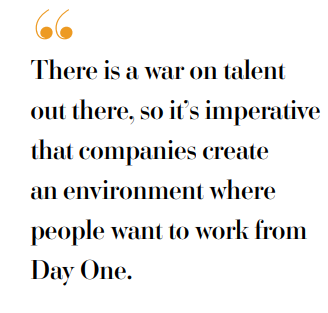Investing in emerging professional voices now is the key to future success.
There is a war on talent out there, so it’s imperative that companies create an environment where people want to work from Day One.
There are two key questions that every direct selling company should be asking right now: How do we bring new people into the industry? And how do we keep the talent we already have?
The past two years have been called the Great Resignation, but I think we should reframe that as the Great Realignment. People have experienced a traumatic, generation-defining pandemic. Most aren’t quitting because they don’t want a job, they’re just switching away from jobs that are no longer the right fit for them.
This group career shift means we are seeing the most competitive hiring landscape ever, and one that our data shows requires a different approach than it did before. Young professional applicants don’t just want to get paid well, they also want more scheduling freedom; the space to be creative; better integration of technology; and more emphasis on social causes that matter. What worked for one generation may not be what the next one is looking for. This is a season of values clarification for workers, and it can be an enormous opportunity for us to recruit and invest in the right team members—but only if we’re willing to smartly adapt.
Sell the Sizzle and Find Fit Fast
We rigorously tested job descriptions and found that younger generations often don’t read to the bottom of the job description, they often skim the first paragraph to see if it catches their attention and, if not, move on to the next job opening. Capturing attention and interest has to happen in the first paragraph of the job description. Sell the sizzle upfront by placing scheduling flexibility, salary, benefits and social causes in the very first paragraph.

loreanto/shutterstock.com
When posting that job description, find out where your ideal candidates are and then meet them there. That might mean advertising on Indeed or Ladders; promoting the job opening via professional or college alumni associations; or recognizing that the right hire may not be from within the industry or even very knowledgeable about the industry.
Once you find a potential hire, speed is essential. Video interviews are now often viewed as the norm, so don’t get mired in scheduling conflicts while you wait for an in-person meeting. The sooner you can have a conversation, the sooner you can talk with the candidate and determine whether you are the right fit for going further into the recruiting process.
Winning the War on Talent
Something new and pervasive that we’ve found to be true at every level of employment, including leadership positions, is the problem of ghosting. This means that someone is hired for a job, accepts the job, but then they don’t report for their first day of work. We’ve seen this happen from leadership roles to frontline team members. No industry or position seems immune.
Ghosting puts tremendous strain on an organization because they’ve gone through the process of preparing for the candidate and adding their talent to the team, yet they no-show or cancel at the last minute. All of this is hard on the team and company doing the hiring.
The best solution that we’ve found to combat this problem is text message onboarding. Yes, text message onboarding. Texting the new hire all the way through to their first day, our insights show, drives an increase in the number of people who actually show up for the job. There are a variety of services, like Enboarder, that can automate this for companies at scale; measure the results; and continually provide the insights that leaders need—all by text.

This approach can also be wielded to provide a highly personalized welcome that drives engagement on Day One. By automated text, leaders can discover a new employee’s personal preferences and then create a custom welcome experience, like having their favorite snack waiting on their desk when they arrive, or inviting them to lunch with the executive team at the local eatery they said they loved. It might also be sending them a personalized Welcome Package if they’re starting virtually that still makes them feel like part of the team.
It’s these sort of “wow” experiences that we want to try to create, particularly as we recruit different generations of executives. These added layers of interaction aren’t something companies have had to focus on before but are now well worth the effort and minimal cost. There is a war on talent out there, so it’s imperative that companies create an environment where people want to work from Day One.
Empower and Equip
Hiring the right person is not the finish line. In fact, it’s a real risk to companies to not develop people once they are under your company umbrella. We’re big advocates for giving talent their own professional development budget—even if it’s only $100 per year—and empowering them to decide what online courses, training, learning experiences or books they’d like to use to advance their skills, talent and mindset.
Beyond that, establishing an actual talent development program is essential. This can be as informal as a quarterly sit-down in a small group with a senior executive that allows young professionals the space to have engaged and constructive conversations or as formal as regular projects that pair junior executives with senior executives to solve a challenge. This cross-generational format provides a great opportunity for senior staff to identify and engage their next level of talent, while infusing initiatives with the innovation and values that more diversity in age, generation and life stage can provide.
The next generation has a different relationship with technology; a different approach to problem solving; and a different set of social causes and missions that our research has shown is also relevant to other generations. Adding younger generations of talent to executive meetings and including their voices is the key way to harness that unique viewpoint.
Succession Planning Is Key
If a company’s entire executive team is within a generation of the CEO, when that person retires, much of the talent around them might be poised to leave, too. Stability is found in making sure the next generation of leaders are not only ready to go but excited to grow the organization. Promoting and preparing younger professional voices is one of the most important ways a company can future-proof itself. Succession planning may not be a hot topic at a leadership or strategy meeting, but it’s absolutely essential for long-term organizational stability, innovation and growth.
Ask yourself, when your key leadership retires, will there be an enthusiastic and equipped group of younger executives ready to lead?

NDAB Creativity/shutterstock.com
4 Tips To Keep Younger Executives Engaged
1 / Communication is critical. The younger a person, the more frequently they may want to connect with bosses and colleagues. This doesn’t mean an overwhelming amount of information but rather short messages that drive tangible engagement, such as a group text or a thread on Slack. This is even more relevant for hybrid or remote workers.
2 / Assign projects, not just responsibility. Younger people are project- and outcome-driven. Give them the opportunity to show you what they can do.
3 / Create more multigenerational teams. Working with new and different generations keeps people interested and adds valuable diversity of thought.
4 / Highlight progress when you can’t deliver promotions. Younger generations have a higher expectation for frequency of promotions, yet many companies can’t promote quickly. In fact, our research shows that younger adults might even think that if they’re not getting promoted, they’re not moving forward. If you can’t deliver promotions, instead take the time to highlight how that young professional is learning and growing in different, valuable ways between their annual review or raise.
How to Future-Proof Your Business
Through our research at the Center for Generational Kinetics, we’ve proven that generational insights—especially when considered within geographical context—are powerful and predictive clues to faster connect, build trust and drive influence. Understanding generations provides a tremendous head start for leaders in understanding as well as creating empathy for and appreciation of seeing the world through a segment of the population’s eyes.
All of us want to feel loved, included, valued and to believe that our work matters, but how we go about pursuing those outcomes can be different, particularly when it comes to different generations and communication, learning, incentives, events and training. Understanding these cross-generational strengths, differences and opportunities can help us future-proof our businesses. And if we don’t adapt to younger generations, someone else will—full stop.
3 Hard Truths about Attracting Millennials & Gen Z:
1 / “Mobile first” is no longer good enough, you have to be mobile only. If distributors have to leave their smartphone to complete any task that is part of their business—run an e-commerce store, enroll someone—you’ve just lost a huge number of people.
2 / One-size-fits-all doesn’t work with younger generations; and, frankly, older generations don’t like it either. Creating deeper personalization that is predictive and knows what customers and distributors need, when they need it, is key. No one should have to go to a big arena rally to learn how to be successful. Great training should be on-demand.
3 / Younger generations expect to be able to earn things faster. Gen Z and Millennials need to feel like they’re moving forward and don’t automatically connect building loyalty with a willingness to wait a long time for rewards. To them, loyalty should be rewarded even if it’s only their first purchase!

Jason Dorsey has become the world’s foremost expert on generational research. He has appeared on 200+ television shows and has headlined events worldwide, sharing his global view of generational differences and helping separate generation myth from truth through data. For more insights from Jason Dorsey, listen to his full interview on The Direct Approach podcast.
From the March 2022 issue of Direct Selling News magazine.


